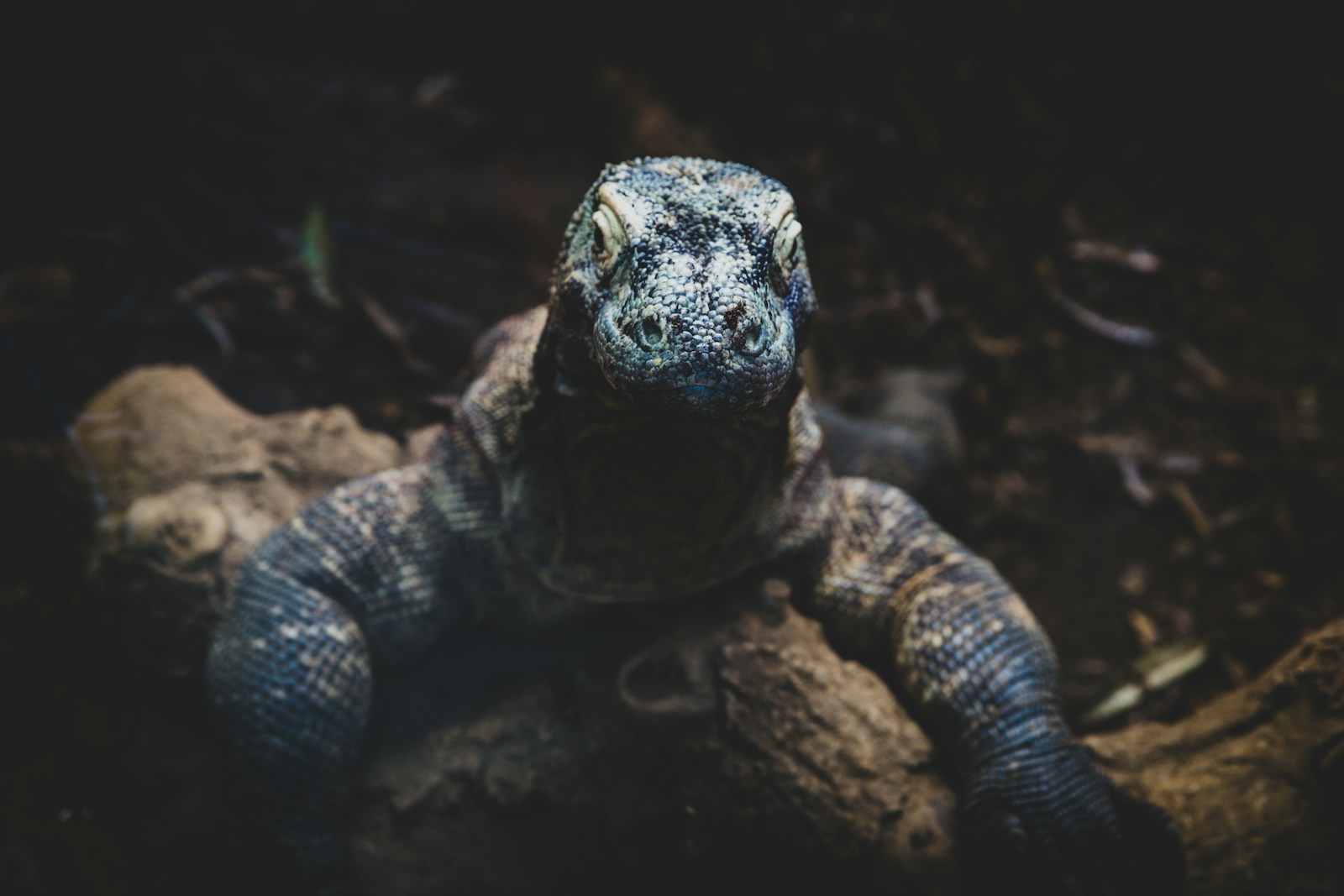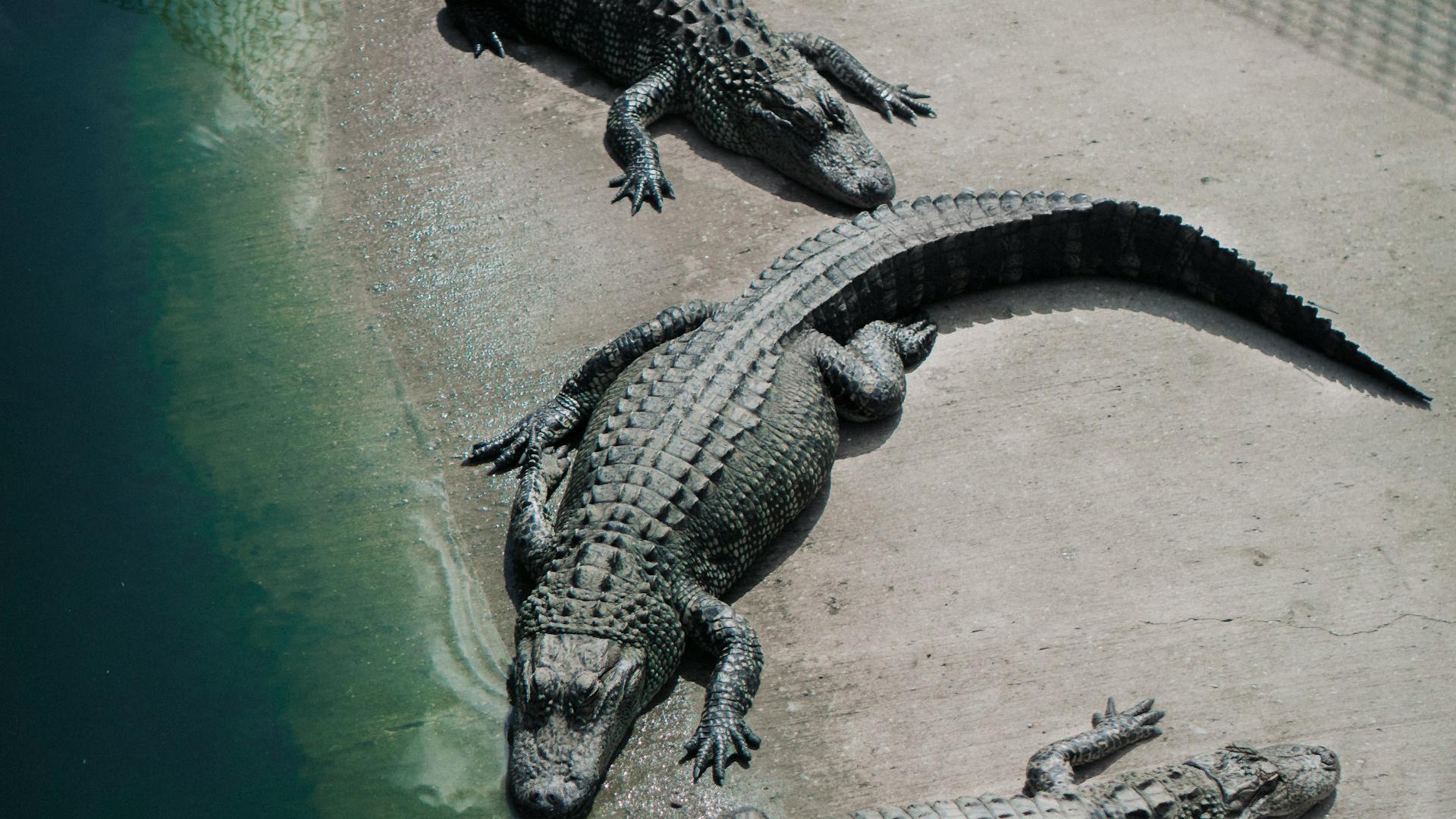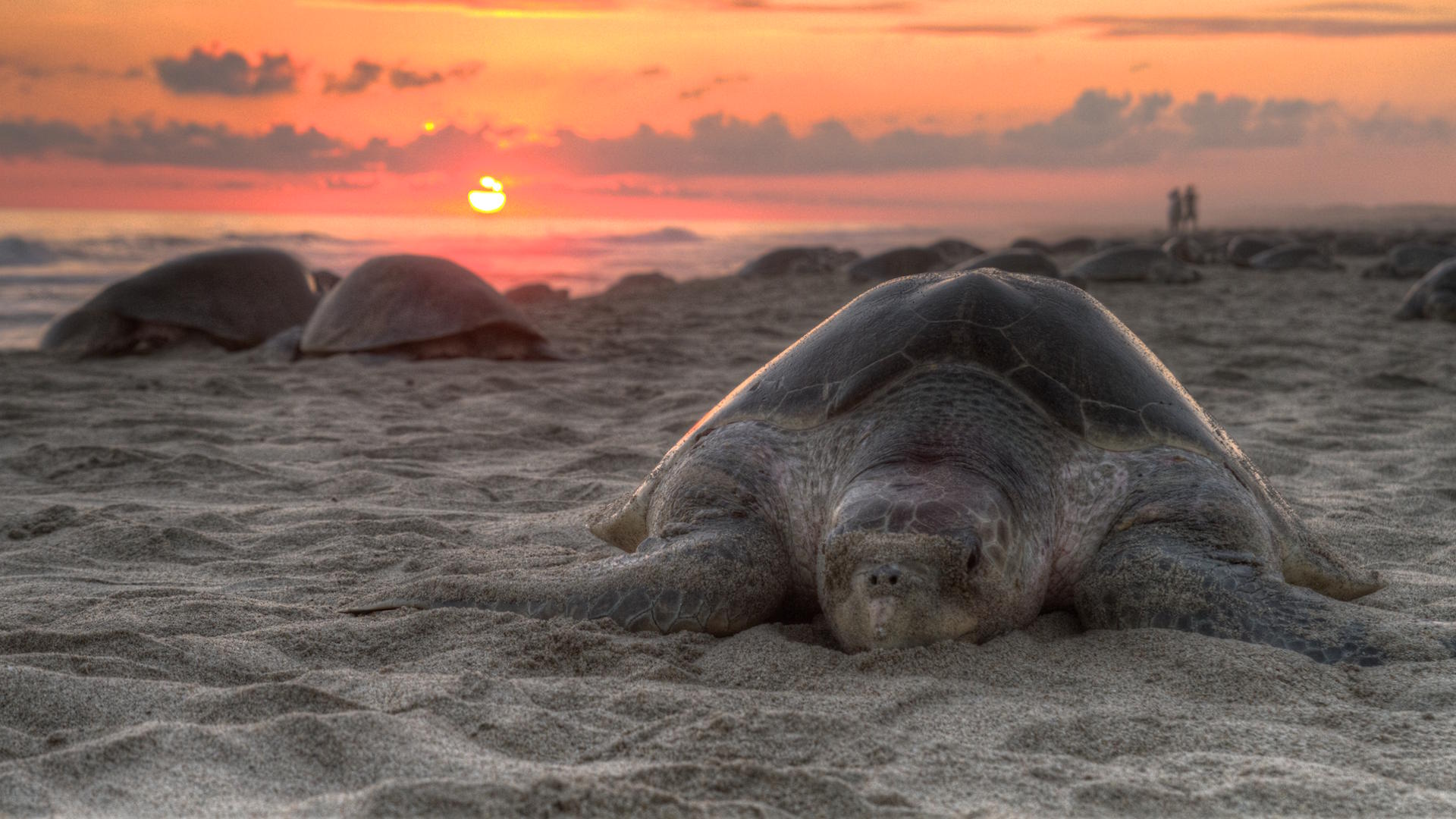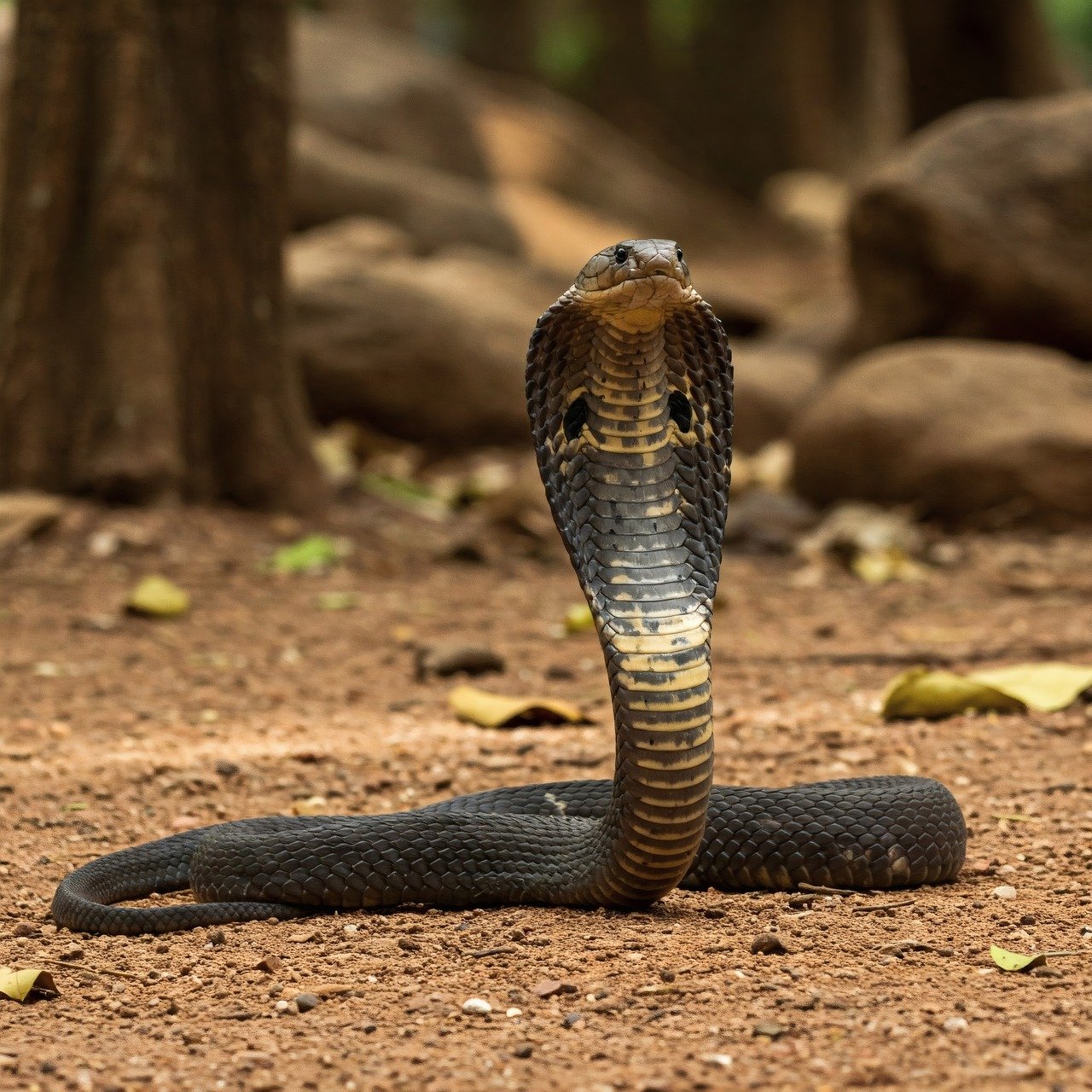The world’s largest lizard species, the Komodo dragon, has fascinated scientists and wildlife enthusiasts for generations with its formidable hunting capabilities. These prehistoric-looking reptiles, native to Indonesia’s Lesser Sunda Islands, have evolved into apex predators with hunting methods that combine patience, power, and biological weaponry unlike any other reptile on Earth. While they may appear sluggish at first glance, Komodo dragons employ sophisticated strategies that make them one of nature’s most effective hunters. Their ability to take down prey several times their own weight—including water buffalo, deer, and wild pigs—demonstrates their exceptional adaptation to their island ecosystem and their position at the top of their food chain.
The Formidable Physical Traits of Komodo Dragons
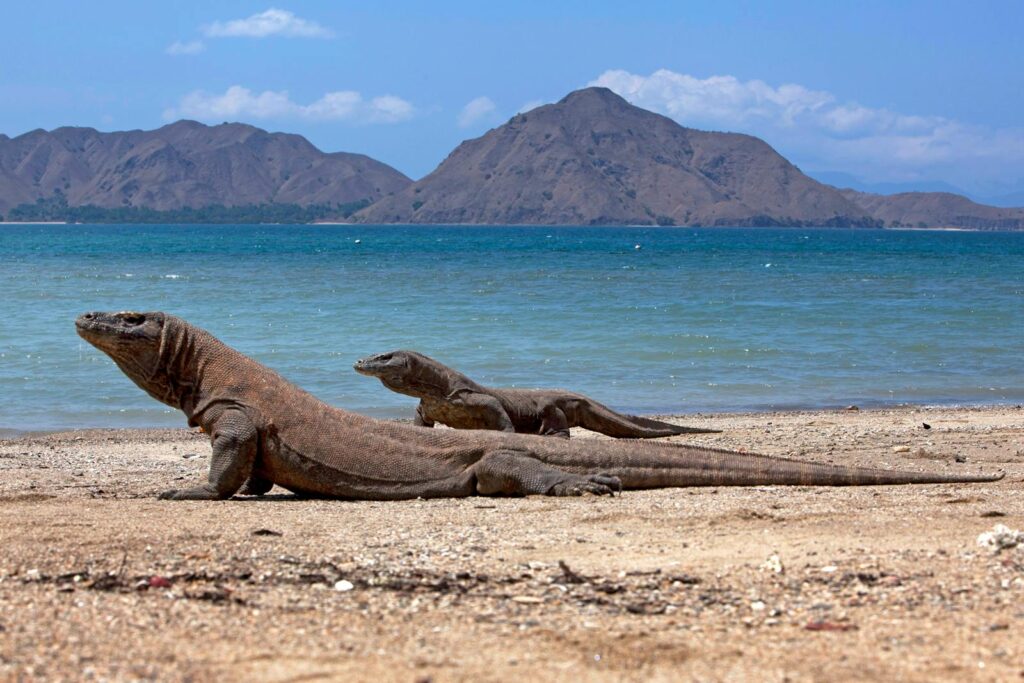
Komodo dragons (Varanus komodoensis) are imposing creatures, typically measuring between 8 to 10 feet in length and weighing up to 200 pounds, making them the heaviest lizards on the planet. Their muscular bodies support powerful limbs that allow for surprising bursts of speed—up to 12 miles per hour in short sprints—enabling them to ambush unsuspecting prey. Their tails, nearly as long as their bodies, serve both as powerful weapons and as counterbalances when running. Perhaps most distinctive are their specialized serrated teeth, which number approximately 60 and can measure up to one inch long, designed to tear flesh effectively while maintaining a firm grip on struggling prey. These physical adaptations combine to create a predator perfectly evolved for its hunting strategy.
The Patient Ambush Strategy
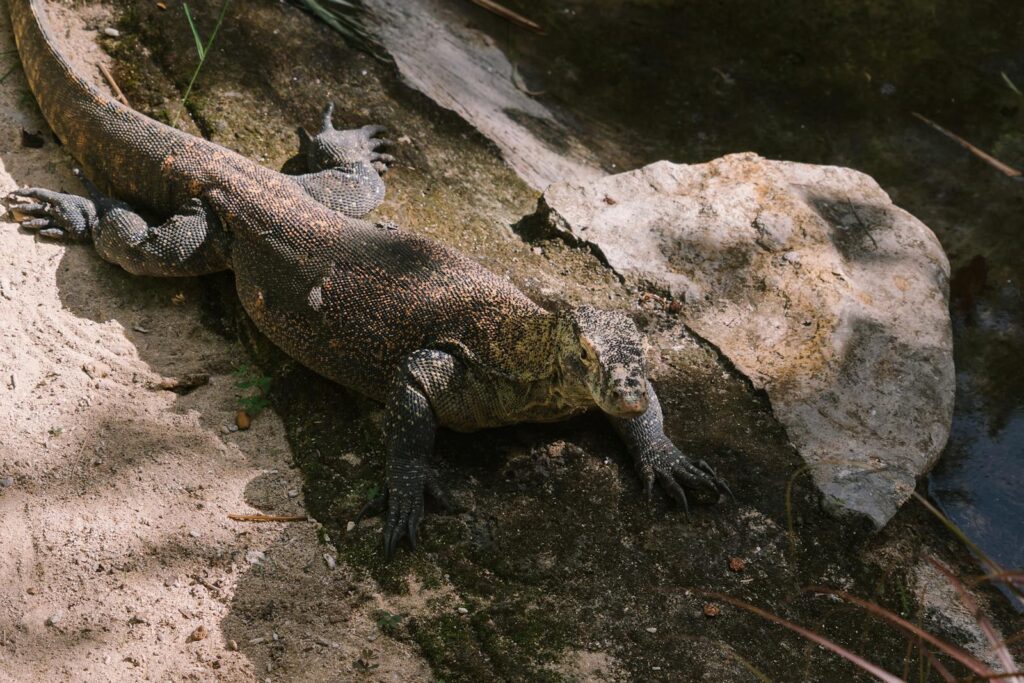
Komodo dragons are masters of the ambush, often spending hours concealed in strategic locations along game trails or near water sources. Their mottled, brownish coloration provides excellent camouflage against the dry landscape of their native islands. With remarkable patience, a Komodo dragon can remain motionless for hours, conserving energy while waiting for potential prey to approach within striking distance. Their excellent vision allows them to spot movement from up to 300 yards away, though they primarily hunt based on sensing nearby activity. When the opportune moment arrives, they explode from their hiding position with surprising speed, often targeting the legs or underside of their prey to maximize damage and minimize risk to themselves. This carefully executed ambush technique compensates for their inability to sustain high speeds over long distances.
The Deadly Bite: More Than Just Teeth
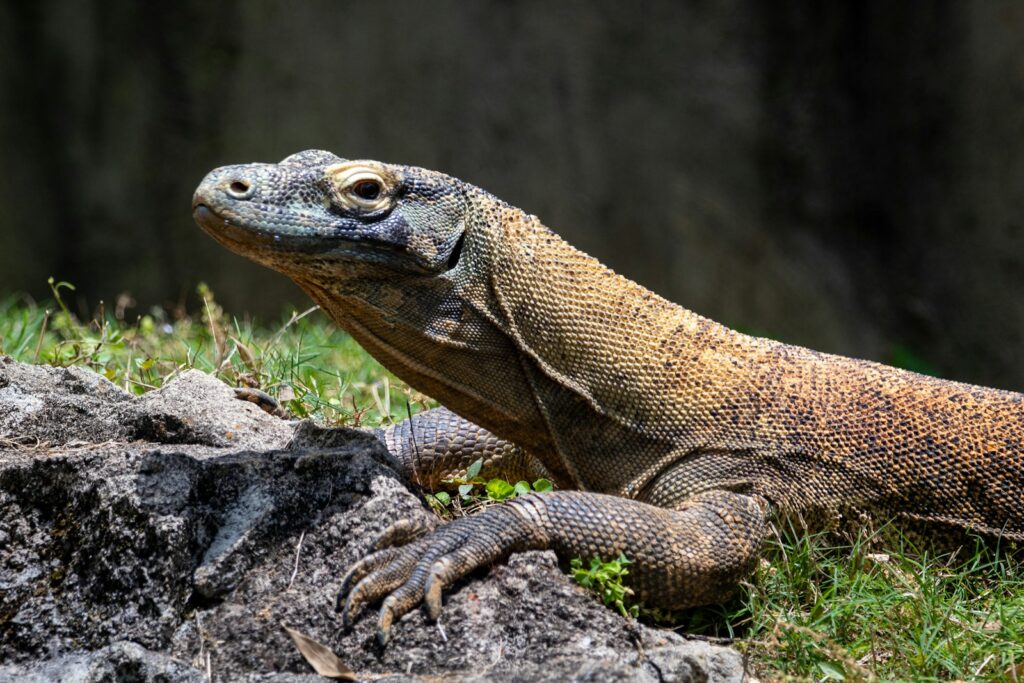
The Komodo dragon’s bite delivers more than just mechanical damage—it’s a sophisticated biological weapon system. When a Komodo bites its prey, it inflicts deep, gaping wounds that bleed profusely due to the presence of anticoagulant compounds in their saliva. Scientific research has identified that Komodo dragons possess venom glands in their lower jaws that produce toxins capable of inducing shock, lowering blood pressure, and preventing blood clotting in their victims. This venom, delivered through their deeply grooved teeth, significantly accelerates blood loss and weakens larger prey that might initially escape the attack. The combination of serrated teeth, powerful jaw muscles capable of exerting up to 39 kilograms of force, and toxic venom makes even a single bite potentially fatal, though the death may come hours or even days later.
The Bacterial Theory: Myth vs. Reality

For decades, scientists believed that Komodo dragons relied on septic bacteria in their mouths to kill prey through infection after a bite. This theory suggested that their saliva harbored over 50 strains of bacteria that would quickly induce sepsis in bitten animals. However, more recent research has largely debunked this as the primary killing mechanism. While Komodo dragons do indeed have bacteria in their mouths (as do most predators), studies have shown that their oral flora isn’t exceptionally more dangerous than that of other carnivores. The revelation of specialized venom glands in 2009 shifted scientific understanding, demonstrating that their prey succumb primarily to the effects of venom rather than bacterial infection. This clarification has been important in understanding the true nature of the Komodo’s hunting efficiency.
The Relentless Pursuit
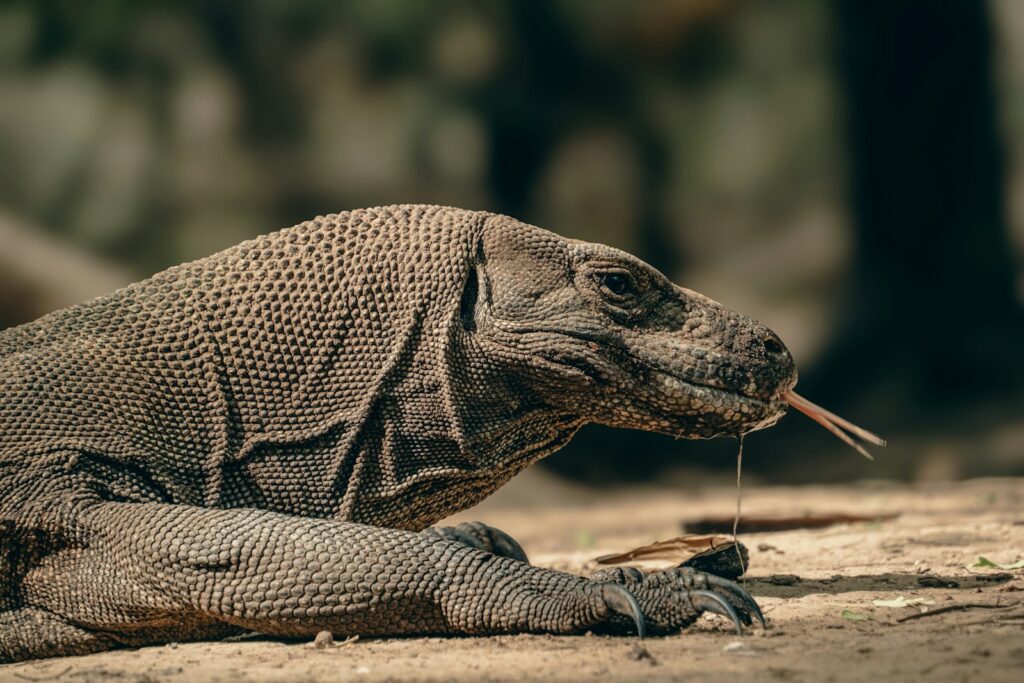
When larger prey manages to escape the initial attack, Komodo dragons employ a strategy of persistent pursuit rather than giving up. After delivering their venomous bite, they will often follow the wounded animal for miles if necessary, using their exceptional sense of smell to track blood trails even over difficult terrain. The dragon’s tracking ability is so refined that they can detect a carcass from up to 5.9 miles away under ideal conditions. This relentless pursuit is made possible by the dragon’s remarkable stamina and their relatively efficient metabolism for a reptile. Komodo dragons can maintain a walking pace for hours while trailing injured prey, periodically testing the air with their forked tongues to follow the scent. This patience pays off when the envenomated prey eventually weakens, slows, and ultimately collapses from the combined effects of blood loss, shock, and venom.
The Fatal Feeding Frenzy
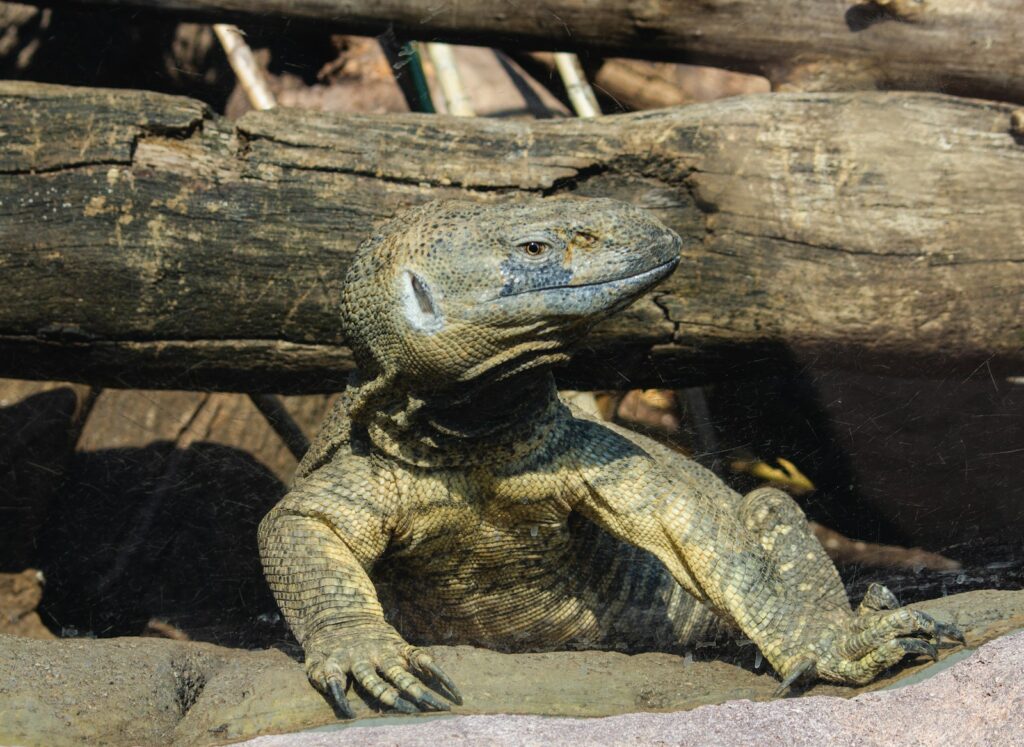
When a Komodo dragon finally overcomes its prey, the feeding process is both efficient and brutal. They begin consuming their prey while it is often still alive, using their powerful neck muscles and serrated teeth to tear off large chunks of meat which they swallow whole. A hungry adult Komodo can consume up to 80% of its body weight in a single feeding, an extraordinary amount that can sustain the reptile for weeks or even months. Their expandable jaws, flexible skulls, and loosely articulated jaws allow them to swallow surprisingly large pieces with minimal chewing. During feeding, Komodo dragons may engage in a behavior known as “death rolling”—similar to crocodilians—where they spin their bodies to tear off manageable chunks from larger carcasses. After gorging themselves, they clear the area of bone fragments and indigestible materials by raking their bodies over rough surfaces.
Hunting in Groups: Social Strategy
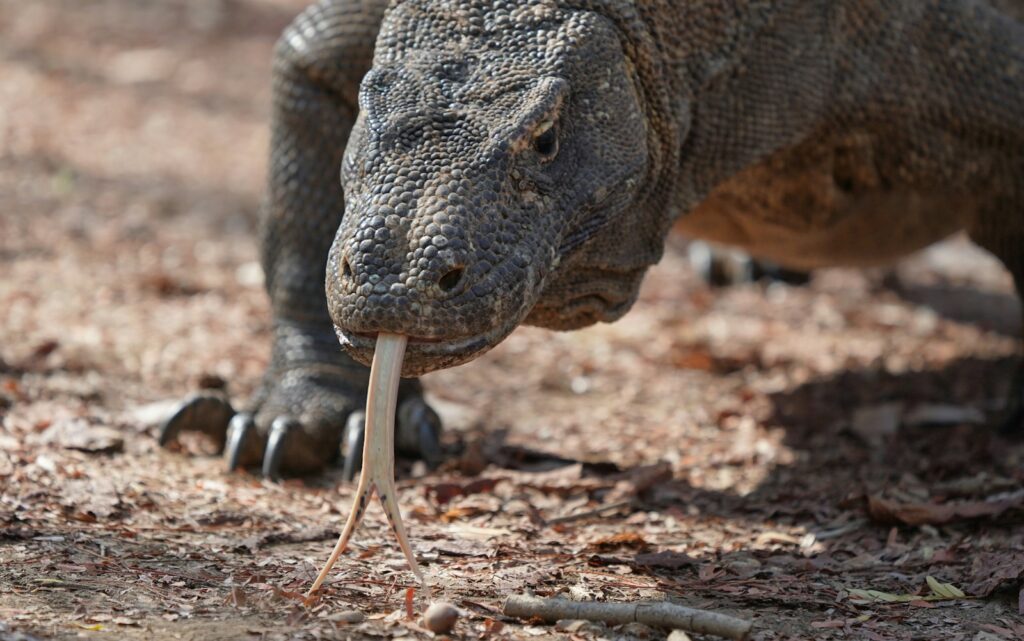
Although generally solitary, Komodo dragons occasionally demonstrate sophisticated group hunting behaviors that increase their ability to take down exceptionally large prey. When targeting large ungulates like water buffalo, multiple dragons sometimes coordinate their attacks, with different individuals targeting the prey from various angles. This coordinated effort can confuse and overwhelm even powerful prey animals that might fend off a single attacker. Interestingly, this cooperation breaks down immediately after the kill, as Komodo dragons follow a strict size-based hierarchy during feeding. The largest dragons eat first, while smaller individuals wait their turn or risk becoming prey themselves. Young dragons have evolved to recognize this danger, often feeding in trees to avoid larger cannibalistic adults who can’t climb as efficiently.
Specialization in Large Prey Hunting
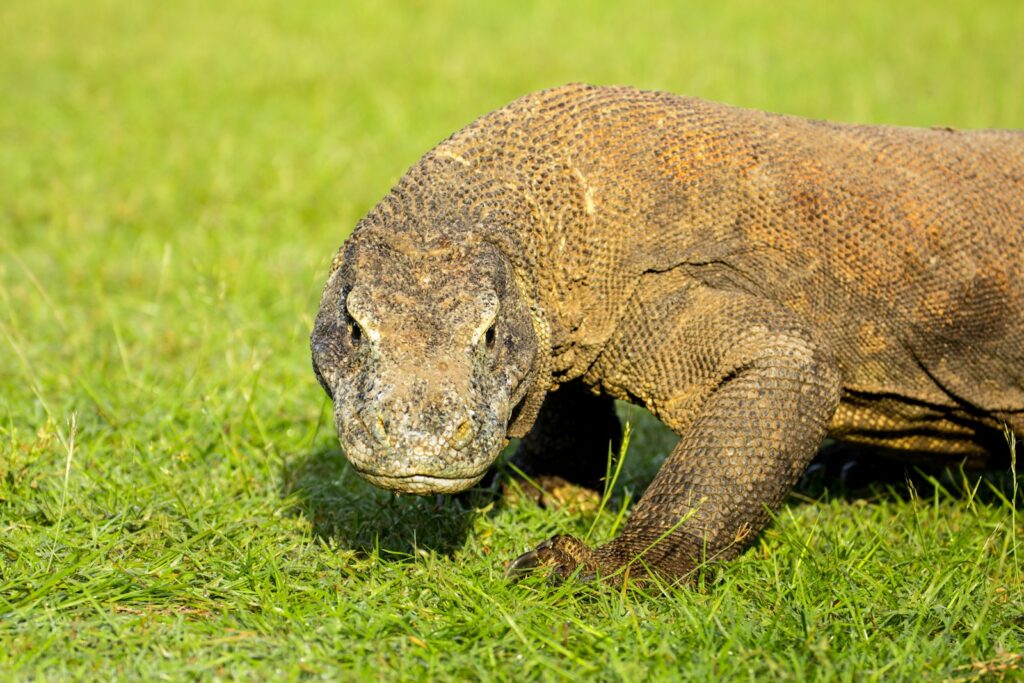
Komodo dragons have evolved to specialize in hunting large mammals, particularly deer, wild boar, and water buffalo—the latter sometimes weighing over ten times the dragon’s own weight. This specialization represents an extraordinary ecological adaptation, as it allows them to maximize energy intake while minimizing hunting frequency. Their hunting strategy against large prey shows remarkable efficiency: they target critical anatomical areas like the throat, major blood vessels, or the soft underside to maximize damage. When hunting larger prey like water buffalo, dragons often deliberately target the legs first, hamstringing the animal to prevent escape before delivering the fatal bite to more vulnerable areas. This strategic approach demonstrates sophisticated predatory intelligence rarely seen in reptiles, as they appear to assess prey vulnerability and adjust their attack patterns accordingly.
Adaptations for Scavenging
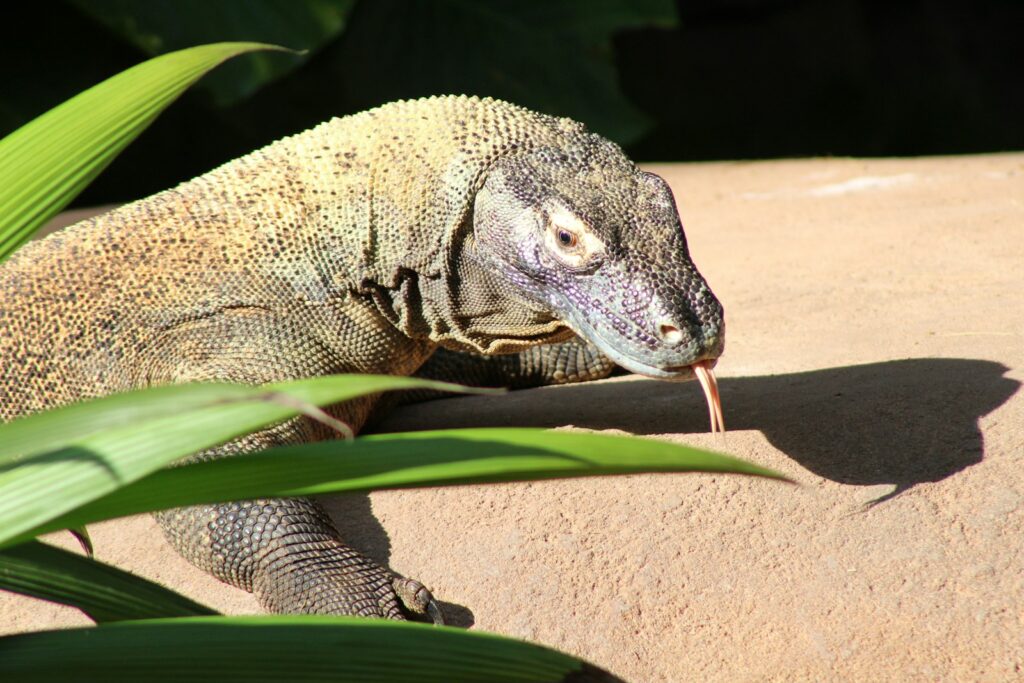
While skilled hunters, Komodo dragons are equally adapted for efficient scavenging, which forms a significant portion of their feeding ecology. Their extraordinary sense of smell allows them to detect carrion from remarkable distances, enabling them to locate food sources with minimal energy expenditure. Komodo dragons possess digestive systems that give them immunity to many forms of food poisoning that would affect other predators, allowing them to safely consume putrefying carcasses several days old. Their stomach acid is exceptionally corrosive, capable of digesting nearly 90% of what they consume, including bones, hooves, and other tissues most predators cannot process. This adaptation for consuming virtually every part of a carcass represents a crucial energy-conservation strategy in their sometimes resource-limited island habitats, where large prey may not always be abundant.
The Role of the Environment in Hunting Success
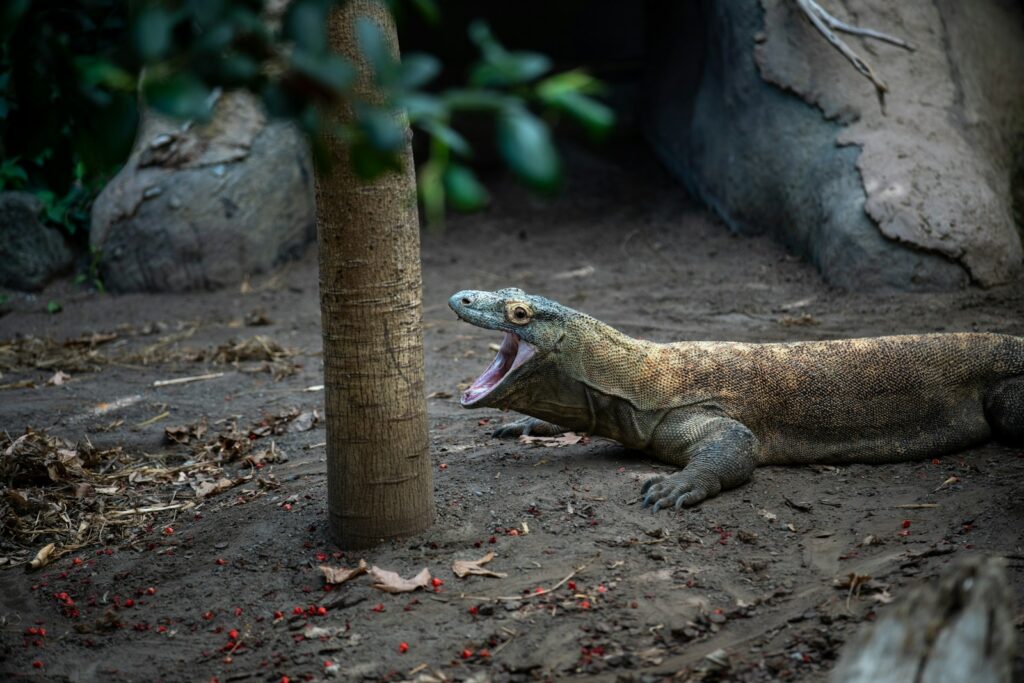
The unique island ecosystems where Komodo dragons evolved have shaped their hunting strategies in profound ways. The relatively dry, open woodlands and savannas of islands like Komodo, Rinca, and Flores create ideal conditions for ambush predation, with numerous game trails and limited escape routes for prey. Water sources become critical focal points for hunting, especially during the dry season when prey animals are forced to visit specific locations to drink. Komodo dragons take advantage of the islands’ rugged terrain, using ridgelines and elevated positions both for spotting distant prey and for ambush opportunities. The isolation of these islands has also meant that the large mammals living there evolved without exposure to large mammalian predators, potentially making them more vulnerable to the dragons’ hunting techniques than mainland counterparts that co-evolved with big cats and other predators.
Young Dragons: Different Hunting Strategies
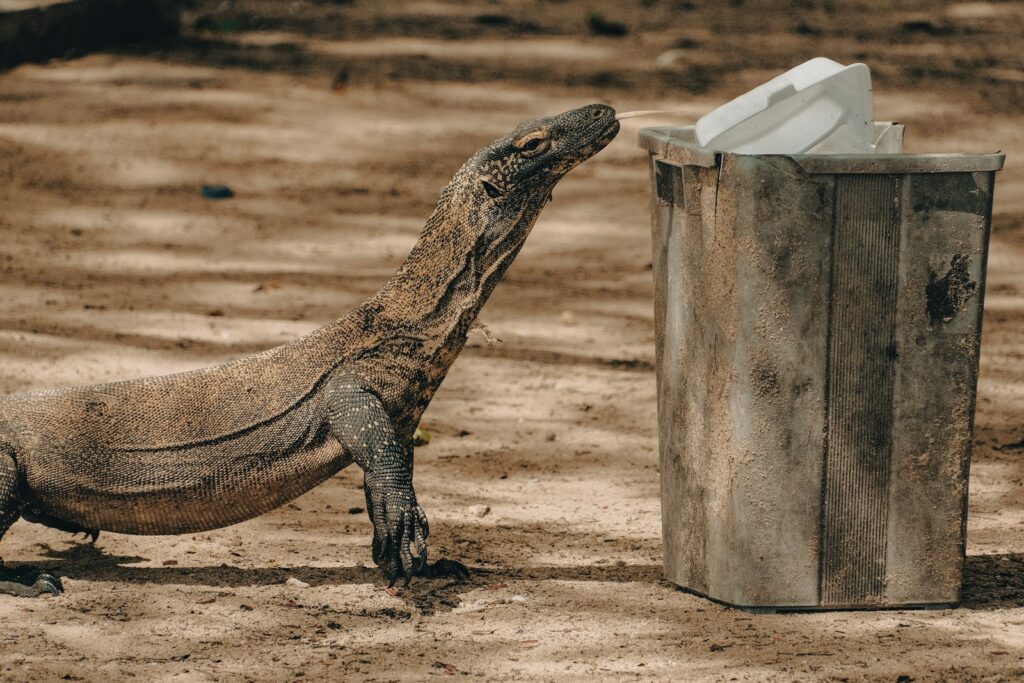
Young Komodo dragons employ dramatically different hunting strategies than adults, demonstrating the species’ behavioral plasticity across its lifespan. Juvenile dragons, being much smaller and vulnerable to predation by adults, spend much of their early lives in trees, where they hunt birds, eggs, smaller reptiles, and insects. These young dragons are significantly more agile climbers than adults, with sharper claws and lighter bodies that allow them to pursue prey into the canopy. They typically employ more active hunting techniques, chasing down smaller prey rather than ambushing larger animals. As they grow larger and heavier, usually around three to four years of age, young dragons gradually transition to ground-dwelling habits and begin developing the patience required for the ambush hunting style of adults. This ontogenetic shift in hunting strategy represents a remarkable adaptation that reduces competition between age classes and decreases cannibalism risk.
The Evolution of Komodo Dragon Hunting Methods
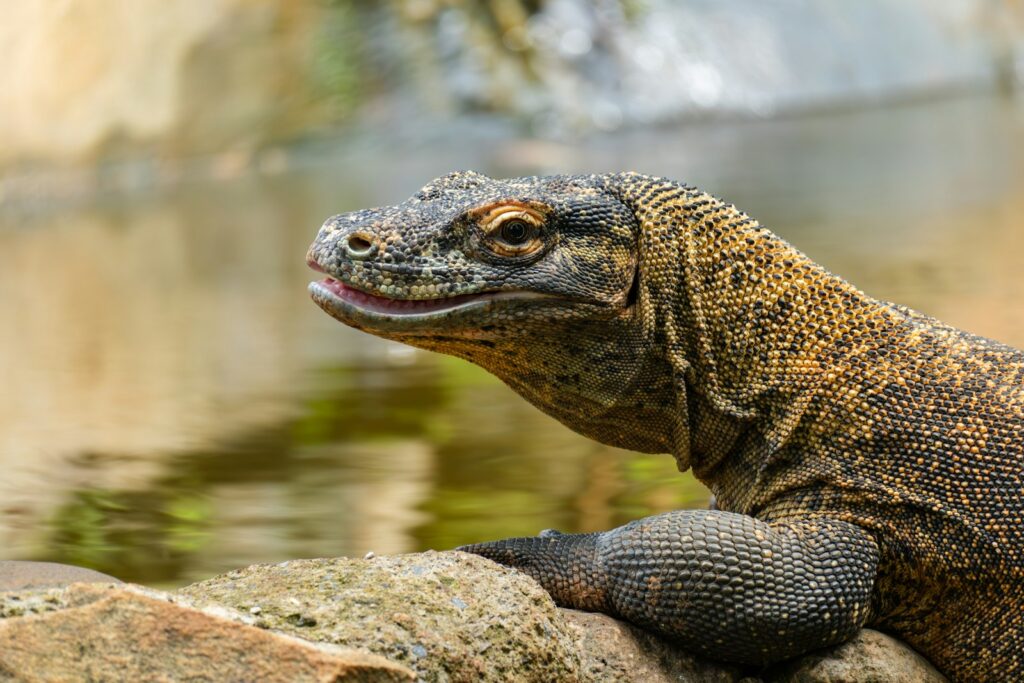
The evolution of the Komodo dragon’s formidable hunting abilities represents a fascinating example of island gigantism and specialized predatory adaptation. Fossil evidence suggests that Komodo dragons descended from smaller monitor lizards that colonized the Indonesian islands from Australia approximately 4 million years ago. Without mammalian competitors like big cats, these lizards evolved larger body sizes and more specialized predatory features to fill the top predator niche. Their venom system likely evolved as a means to efficiently subdue large prey while minimizing physical risk to the predator—a strategy particularly valuable when hunting dangerous prey like water buffalo. The dragons’ hunting methods appear to be an evolutionary response to the specific prey species available on their native islands, particularly the now-extinct pygmy elephant Stegodon and later the introduced deer, pigs, and water buffalo. This evolutionary story illustrates how isolation on islands can drive the development of unique predatory strategies found nowhere else on Earth.
Conservation Implications for the World’s Largest Lizard

Understanding the hunting behavior of Komodo dragons has significant implications for their conservation as vulnerable species. The dragons require large territories with sufficient prey populations to sustain their unique hunting strategies, making habitat preservation crucial to their survival. Human encroachment on Komodo habitat has reduced both their range and prey availability, forcing adaptations in their hunting patterns—sometimes leading to conflicts when dragons target livestock. Conservation efforts must consider the specialized predator-prey relationships that have evolved on these islands over millions of years. Ecotourism centered around observing these fascinating predators provides economic incentives for protection but must be managed carefully to avoid disrupting natural hunting behaviors. As climate change threatens to alter the delicate island ecosystems they inhabit, preserving intact landscapes where Komodo dragons can continue their ancient hunting practices becomes increasingly vital for ensuring the survival of these remarkable living dragons.
Conclusion

The hunting strategies of Komodo dragons represent one of nature’s most remarkable examples of predatory evolution. Through a combination of patient ambush techniques, venomous bites, relentless pursuit, and efficient feeding, these ancient reptiles have maintained their position as apex predators in their island ecosystems for millions of years. Their unique adaptations—from venom-delivering bites to their extraordinary sensory capabilities—demonstrate how isolation on Indonesia’s Lesser Sunda Islands drove the evolution of hunting methods found nowhere else among reptiles. As scientists continue to study these magnificent predators, our understanding of their sophisticated hunting behavior continues to deepen, revealing that these “dragons” are not merely relics of a prehistoric past but highly evolved modern predators whose hunting prowess deserves both our scientific interest and conservation efforts. Protecting Komodo dragons means preserving not just a species, but an extraordinary predatory relationship that has shaped an entire island ecosystem.

